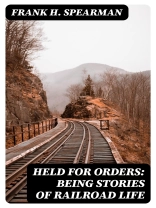In ‘Held for Orders: Being Stories of Railroad Life, ‘ Frank H. Spearman intricately weaves a rich tapestry of narratives that reflect the vibrant and often tumultuous world of early 20th-century railroading. The book employs a blend of realism and anecdotal storytelling, presenting portraits of both the heroic and the mundane aspects of the railroad life. Spearman seamlessly captures the intricacies of the railway industry, from the struggles of the workers to the technological advancements of the time, all while employing a narrative style that balances humor and poignancy, effectively immersing readers in the experiences of its characters. Frank H. Spearman was not only a writer but also an influential figure in the railroad industry, serving in various capacities and gaining first-hand experience that informed his literary oeuvre. His deep understanding of the costs and consequences of railroad expansion, combined with a passion for storytelling, positioned him as a unique voice in American literature. His commitment to portraying the human element behind the mechanized world further enriches the narratives found within this collection. A must-read for enthusiasts of Americana and railroad history, ‘Held for Orders’ serves as a significant exploration of the human condition through the lens of a pivotal industry. Spearman’s insightful stories resonate with timeless themes of ambition, resilience, and community, making this collection not only engaging but also essential for understanding the socio-economic landscapes of its era.
Circa l’autore
Frank Hamilton Spearman (1859–1937) was an American author known for his captivating works that intricately depicted the rugged life and dynamic atmosphere of the railroad scenes of the early 20th century. Spearman’s ability to weave tales around the railroads stemmed from his profound interest in them, which transcended mere background settings to become pulsating entities in his stories. One of his notable collections of short stories is ‘Held for Orders: Being Stories of Railroad Life, ‘ which was published in 1901. This anthology effectively captures the essence of the human spirit amidst the iron tracks, presenting a vivid tableau of characters, from engineers to rail workers, all brought to life through his eloquent prose. Spearman’s literary style is characterized by a blend of realism and romanticism, where he marries technical details with human drama to great effect, creating narratives that are both informative and emotionally engaging. His works not only entertain but also preserve the legacy of a bygone era, offering insights into the historical significance of railroads in America’s development. Spearman’s contribution to American literature earned him a reputation as a quintessential storyteller of the American West and cemented his place among the noteworthy writers of his time.












